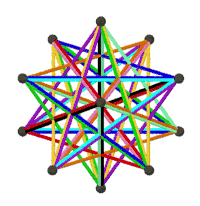Disclaimer: Welcome to the laboratory, explore with an open heart ❤️
Yogi or a Bhogi?

Posted by Holger:
Ron: Greetings to One and All!
A Yogi or a Bhogi?
What are we talking about here?
Am I one of the two, or both,
or neither? Who am I?
We gather again this Sunday
to share our (mis)understandings…
in the spirit of serious play.
Peace Peace Peace
PS Holger – please share the below with your friends from the garden.
If any of them are inclined to sample a taste of our play…
please let them contact me [ron@nondual.community] for the link.
Also, please feel free to advertise the
Garden of Friends

here.
Chapter 26
Personality, an Obstacle
What is the best way to reach perfection?
Q: As I can see, the world is a school of Yoga and life itself is Yoga practice. Everybody strives for perfection and what is Yoga but striving. There is nothing contemptible about the so- called ‘common’ people and their ‘common’ lives…only they are not conscious of their true purpose…Their ultimate goal is the same. What the Yogi secures by renunciation (tyaga) the common man (bhogi) realizes through experience (bhoga). The way of Bhoga is unconscious, therefore, repetitive and protracted, while the way of Yoga is deliberate and intense and, therefore, can be more rapid.
M: Maybe the periods of Yoga and Bhoga alternate. First Bhogi , then Yogi, then again Bhogi, then again Yogi…In reality both the Yogi and the Bhogi follow their own nature, according to circumstances and opportunities. The Yogi’s life is governed by a single desire – to find the Truth; the Bhogi serves many masters. But the Bhogi becomes a Yogi and the Yogi may get a rounding up in a bout of Bhoga. The final result is the same. 97
Q: What is the relationship between the world and consciousness?
M: Before the world was, consciousness was. In consciousness it comes into being, in consciousness it lasts and into pure consciousness it dissolves. At the root of everything, is the feeling ‘I am’. The state of mind: ‘there is a world’ is secondary, for to be, I do not need the world, the world needs me. 98
Q: Is there anything greater than the urge to live?
M: Still greater is the freedom from the urge to live.
Q: The freedom of the stone?
M: Yes, the freedom of the stone, and much more besides. Freedom unlimited and conscious. 98
Q: Is personality an obstacle?
M: As you are now, the personality is only an obstacle. Self-identification may be good for an infant, but true growing up depends on getting the body out of the way. Normally, one should outgrow body-based desires early in life. Even the Bhogi, who does not refuse enjoyments, need not hanker after the ones he has tasted. Habit, desire for repetition, frustrates both the Yogi and the Bhogi. 98
Q: Why do you keep on dismissing the person as of no importance?
M: As long as you do not see that it is a mere habit, built on memory, prompted by desire, you will think yourself to be a person – living, feeling, thinking, active, passive, pleased or pained. Question yourself, ask yourself: ‘Is it so?’ ‘Who am I?’ ‘What is behind and beyond all this? And soon you will see your mistake. And it is in the very nature of a mistake to cease to be, when seen. 98-99
Q: What is Nisarga Yoga?
M: Nisarga yoga implies living in spontaneous awareness, consciousness of effortless living, being fully interested in one’s life. 99
Q: Can I speed up my spiritual practice?
M: Why hurry? Wait till you are fully ripe, mellow and sweet. 99
Q: What is essential for my spiritual practice?
M: Humility and silence are essential for a sadhaka, however advanced. 99
Q: What is the meaning and purpose of duality?
M: There is nothing wrong with duality as long as it does not create conflict. Multiplicity and variety without strife is joy. In pure consciousness there is light. For warmth, contact is needed. Above the unity of being is the union of love.
Love is the meaning and purpose of duality. 100
Q: I want to live a good life, a holy life. What am I to do?
M: Be loyal, be simple, be humble. Hide your virtue, live silently. The five senses and the three qualities (gunas) are your eight steps in Yoga. And ‘I am’ is the Great Reminder (mahamantra). You can learn from them all you need to know. Be attentive, inquire ceaselessly. That is all. 100
Q: What is the realized man like?
M: Neither ordinary, nor extra-ordinary. Just being aware and affectionate – intensely. He looks at himself without indulging in self-definitions and self-identifications. He does not know himself as anything apart from the world. He is the world…He is egoless; he has lost the capacity of identifying himself with anything. He is without location, placeless, beyond space and time, beyond the world. Beyond words and thoughts is he. 101
Q: How does it happen that each person creates their own world?
M: When a number of people are asleep, each dreams their own dream. Only on awakening the question of many different dreams arises and dissolves when they are all seen as dreams, as something imagined. 101
Q: Do dreams have a foundation?
M: In memory. Even then, what is remembered, is but another dream. The memory of the false cannot but give rise to the false. There is nothing wrong with memory as such. What is false is its content. Remember facts, forget opinions. 101
Q: What is a fact?
M: What is perceived in pure awareness, unaffected by desire and fear, is fact. 102
One Source
Related Presenters:
Related Friends:
Image Source:
https://unsplash.com/photos/3QaGzeQbda8
Text from Nisargadatta Maharaj’s book
I AM THAT
Gif animation:
https://commons.wikimedia.org/wiki/File:Petrial_small_stellated_dodecahedron.gif
Category:
Tag:
Created: January 26, 2023
Last modified: January 26, 2023
This post has 1 Comment. (Click here ❤️ to share your words.)
One response to “Yogi or a Bhogi?”
-
Beautiful! “Before the world was, consciousness is.”

Leave a Reply